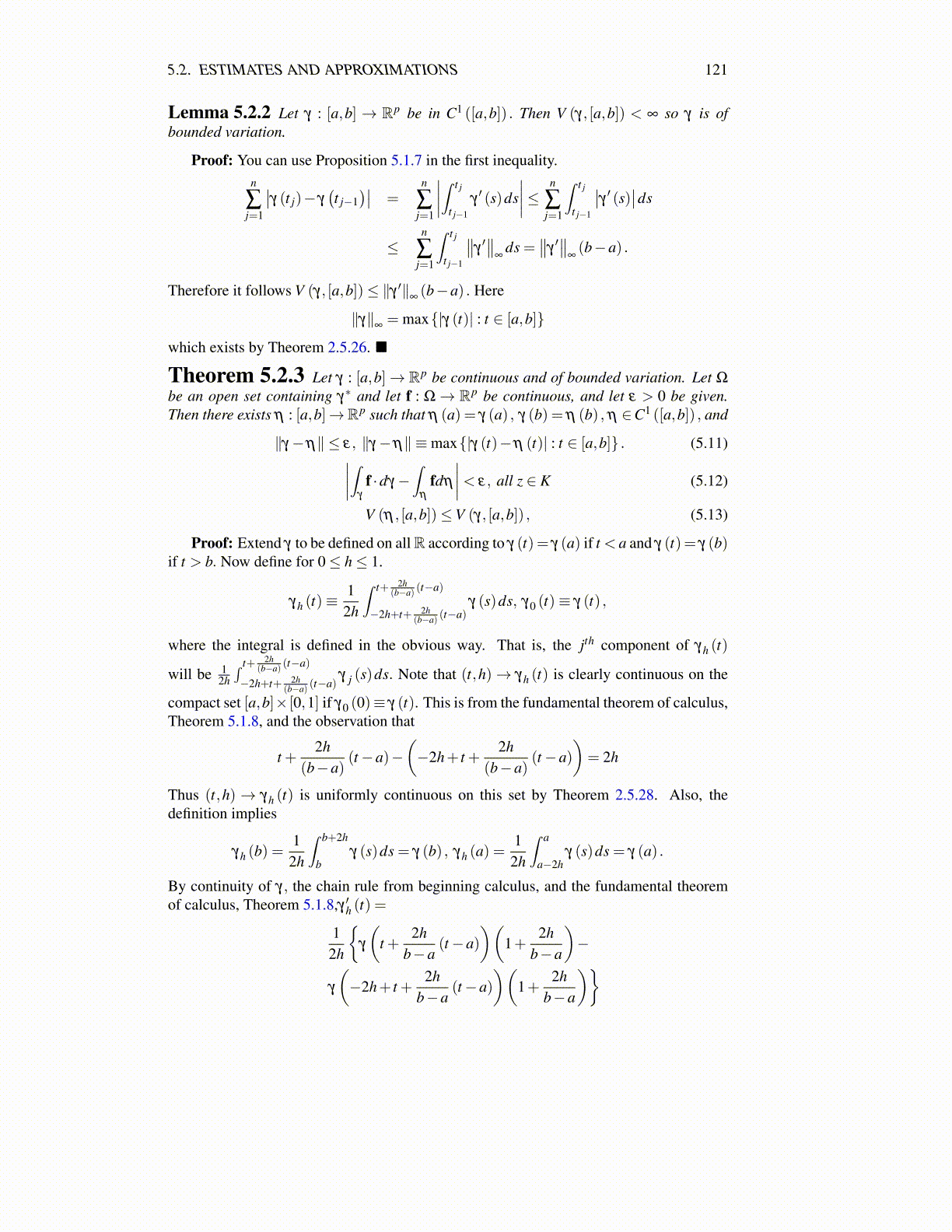
5.2. ESTIMATES AND APPROXIMATIONS 121
Lemma 5.2.2 Let γ : [a,b] → Rp be in C1 ([a,b]) . Then V (γ, [a,b]) < ∞ so γ is ofbounded variation.
Proof: You can use Proposition 5.1.7 in the first inequality.n
∑j=1
∣∣γ (t j)− γ(t j−1
)∣∣ =n
∑j=1
∣∣∣∣∫ t j
t j−1
γ′ (s)ds
∣∣∣∣≤ n
∑j=1
∫ t j
t j−1
∣∣γ ′ (s)∣∣ds
≤n
∑j=1
∫ t j
t j−1
∥∥γ′∥∥
∞ds =
∥∥γ′∥∥
∞(b−a) .
Therefore it follows V (γ, [a,b])≤ ∥γ ′∥∞(b−a) . Here
∥γ∥∞= max{|γ (t)| : t ∈ [a,b]}
which exists by Theorem 2.5.26. ■
Theorem 5.2.3 Let γ : [a,b]→ Rp be continuous and of bounded variation. Let Ω
be an open set containing γ∗ and let f : Ω→ Rp be continuous, and let ε > 0 be given.Then there exists η : [a,b]→Rp such that η (a) = γ (a) , γ (b) = η (b) , η ∈C1 ([a,b]) , and
∥γ−η∥ ≤ ε, ∥γ−η∥ ≡max{|γ (t)−η (t)| : t ∈ [a,b]} . (5.11)∣∣∣∣∫γ
f ·dγ−∫
η
fdη
∣∣∣∣< ε, all z ∈ K (5.12)
V (η , [a,b])≤V (γ, [a,b]) , (5.13)
Proof: Extend γ to be defined on allR according to γ (t)= γ (a) if t < a and γ (t)= γ (b)if t > b. Now define for 0≤ h≤ 1.
γh (t)≡12h
∫ t+ 2h(b−a) (t−a)
−2h+t+ 2h(b−a) (t−a)
γ (s)ds, γ0 (t)≡ γ (t) ,
where the integral is defined in the obvious way. That is, the jth component of γh (t)
will be 12h∫ t+ 2h
(b−a) (t−a)
−2h+t+ 2h(b−a) (t−a)
γ j (s)ds. Note that (t,h)→ γh (t) is clearly continuous on the
compact set [a,b]× [0,1] if γ0 (0)≡ γ (t). This is from the fundamental theorem of calculus,Theorem 5.1.8, and the observation that
t +2h
(b−a)(t−a)−
(−2h+ t +
2h(b−a)
(t−a))= 2h
Thus (t,h) → γh (t) is uniformly continuous on this set by Theorem 2.5.28. Also, thedefinition implies
γh (b) =12h
∫ b+2h
bγ (s)ds = γ (b) , γh (a) =
12h
∫ a
a−2hγ (s)ds = γ (a) .
By continuity of γ, the chain rule from beginning calculus, and the fundamental theoremof calculus, Theorem 5.1.8,γ ′h (t) =
12h
{γ
(t +
2hb−a
(t−a))(
1+2h
b−a
)−
γ
(−2h+ t +
2hb−a
(t−a))(
1+2h
b−a
)}